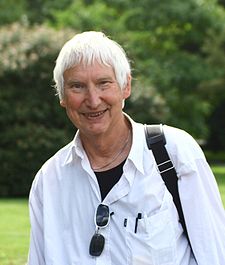- Ole Barndorff-Nielsen
-
Ole Eiler Barndorff-Nielsen 
Ole Barndorff-Nielsen at the Levy conference in Copenhagen in August 2007.Born March 18, 1935
CopenhagenResidence Århus, Denmark Nationality Danish Fields Mathematics Institutions University of Aarhus Known for hyperbolic distribution, Information geometry, maximum likelihood estimator, Lévy processes, Barndorff-Nielsen Shephard stochastic volatility model Ole Eiler Barndorff-Nielsen (born 18 March 1935 in Copenhagen) is a renowned Danish statistician who has contributed to many areas of statistical science. He became interested in statistics when, as a student of actuarial mathematics, he worked part-time at the Department of Biostatistics of the Danish State Serum Institute. He graduated from the University of Aarhus (Denmark) in 1960, where he has spent most of his academic life, and where he became professor of statistics in 1973. However in 1962-1963 and 1963-1964 he stayed at the University of Minnesota and Stanford University, respectively, and from August 1974 to February 1975 he was an Overseas Fellow at Churchill College, Cambridge, and visitor at Statistical Laboratory, Cambridge University.
Contents
Works of Barndorff-Nielsen
Among Barndorff-Nielsen's early scientific contributions are his work on exponential families and on the foundations of statistics, in particular sufficiency and conditional inference. In 1977 he introduced the hyperbolic distribution as a mathematical model of the size distribution of sand grains, formalising heuristic ideas proposed by Ralph Alger Bagnold. He also derived the larger class of generalised hyperbolic distributions. These distributions, in particular the normal-inverse Gaussian (NIG) distribution, have later turned out to be useful in many other areas of science, in particular turbulence and finance. The NIG-distribution is now widely used to describe the distribution of returns from financial assets. Later Barndorff-Nielsen played a leading role in the application of differential geometry to investigate statistical models. Another main contribution is his work on asymptotic methods in statistics, not least his formula for the conditional distribution of the maximum likelihood estimator given an ancillary statistic that generalizes a formula by Ronald A. Fisher (originally called the p * -formula, but now known as the Barndorff-Nielsen formula). He has jointly with David Cox written two influential books on asymptotic techniques in statistics. Since the mid-90s Barndorff-Nielsen has worked on stochastic models in finance (often with Neil Shephard) and turbulence, on statistical methods for the analysis of data from experiments in quantum physics, and has contributed to the theory of Lévy processes. In 1984 he produced a short film[1] on the physics of blown sand and the life of the British scientist and explorer Brigadier Ralph Alger Bagnold.
Notable honors and positions held
Barndorff-Nielsen is a member of the Royal Danish Academy of Sciences and Letters and of Academia Europaea. He has received honorary doctorate degrees from the Université Paul Sabatier, Toulouse and the Katholieke Universiteit Leuven. In 1993-1995 he was a very influential president of the Bernoulli Society for Mathematical Statistics and Probability. He was the editor of International Statistical Review in 1980-1987 and of the journal Bernoulli in 1994-2000. From 1 April 1998 to 31 March 2003 he was Scientific Director of MaPhySto (the Centre for Mathematical Physics and Stochastics), which was a centre devoted to advanced research and training in the fields of mathematical physics and stochastics, as well as some closely related areas.
See also
- Generalised hyperbolic distribution
- Generalized inverse Gaussian distribution
- Hyperbolic distribution
- Information geometry
- List of mathematicians
References
- ^ Barndorff-Nielsen, Ole. 1984. Blown Sand. (film). (MPEG, 196MB) Accessed 28 March 2009.
- Barndorff-Nielsen, Ole (1978). Information and exponential families in statistical theory. Wiley Series in Probability and Mathematical Statistics. Chichester: John Wiley \& Sons, Ltd.. pp. ix+238 pp.. ISBN 0-471-99545-2. MR489333
External links
- Barndorff-Nielsen's CV at web-site of University of Aarhus.
- Barndorff-Nielsen's page in the directory of researchers at the International Center for Scientific Research
- Photo of Barndorff-Nielsen (1998) at the web-site Portraits of Statisticians
- MaPhySto-homepage for Barndorff-Nielsen. Also contains a newer photo.
- The Centre for Mathematical Physics and Stochastics.
- Barndorff-Nielsen, Ole Eiler at ISIHighlyCited.com
Categories:- ISI highly cited researchers
- Members of Academia Europaea
- Danish statisticians
- Danish mathematicians
- Probability theorists
- 21st-century mathematicians
- 1935 births
- Living people
Wikimedia Foundation. 2010.
